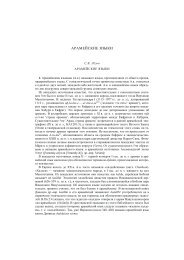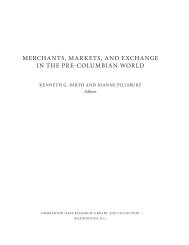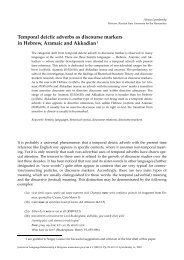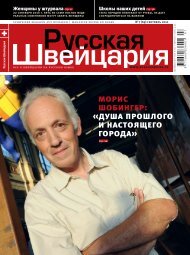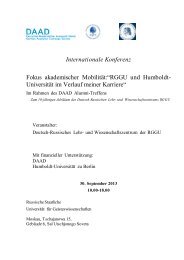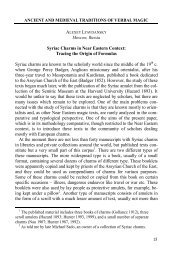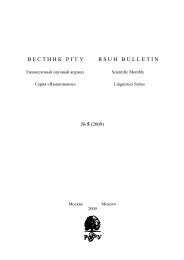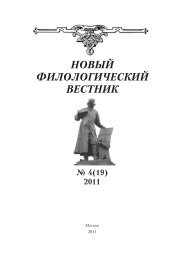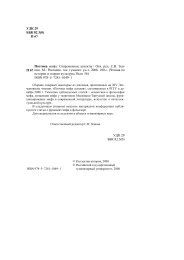782 Morphosyntax and Text Structure in <strong>Akkadian</strong>should not touch [<strong>the</strong> field’]); with a different goal/semantic object: mammanlā i-¢e-e-i-šu-nu-ši-im ‘niemand soll ihnen nahetreten’ (8, 115:7′).The “indicative” Pres. appears in OB letters only with future reference:bēlī ana GN qadum gamarat ummānātīšu i¢-¢e-i-a-am vent. … ištu inanna anaUD.20.KAM i-¢e 4 -e-i-a-am vent. ‘my lord has approached Pf GN with all histroops … within twenty days he will approach Pres here’ (TIM 2, 15:13–19[AbB 8, 15] = CAD à 74b), 62 ištu inanna ana ITI UD.30.KAM e-¢e-i-a-kum‘within a full month from now I will come to you (UET 5, 82rev.:12′ =CAD à 72b), see also ShT, p. 34:37; ARM 10, 4:19 (in a figurative sense).In divination protases, at least one token of <strong>the</strong> Pres. is attested, in“competition” with <strong>the</strong> SC: šumma ¢ulīmum … ina bamat G[ÙB(?)] i(?)-¢e 4 -i-i‘if <strong>the</strong> spleen comes close to <strong>the</strong> left side of <strong>the</strong> chest’ (RA 67, 42:41′ =CAD à 74b). In <strong>the</strong> six stereotyped protases of YOS 10, 46 i 11–35, ¢eûmappears in <strong>the</strong> SC form with <strong>the</strong> ventive, e. g. šumma TUKUL imittim ina rēšmartim ubān lā ¢e 4 -i-a-am šakim-ma šumēlam ina¢¢al ‘if <strong>the</strong> right weapon isnot approaching <strong>the</strong> top of <strong>the</strong> gall bladder, lying one finger distant fromit’ (YOS 10, 46 i 11ff.). 63In OA, <strong>the</strong> Pres.-based prohibitive is well-attested: a-na ba-áp ! -pí-ri 64 ÉŠu-Ištar ma-ma-[an] lá i-¢á-i ‘let nobody approach <strong>the</strong> “beer breads” of <strong>the</strong>Šu-Ištar household’ (CCT 3, 14:27ff.), see also e. g. Prag I 437:6 (lá i-¢á-i). In one instance, <strong>the</strong> negated Pres. codes a habitual situation within<strong>the</strong> ‘negative asseverative form’ marked by <strong>the</strong> subjunctive morpheme(E. Cohen 2005:19, cf. GKT 233d): d A-šur ù DINGIR.ÚI.A-ú-ni li-¢ù-lu mama-ana-na KÙ.pí-kà 1 GÍN la i-¢á-i-ú ‘let Aššur and our gods witness: nobodydoes ever touch even a shekel of your silver’ (KTS 2, 45:28–31); inano<strong>the</strong>r instance this very form refers to <strong>the</strong> future: adi kaspam ša DNuštabbû mamman lā i-¢á-i-ú ‘until he has been paid <strong>the</strong> silver of DN in full,no (o<strong>the</strong>r claimant) will approach (it)’ (CCT 4, 37b:14). 65 The Pres. is also62“He will approach here” is no idiomatic English. The sense is doubtless “hewill arrive here,” “he will come.” See above on <strong>the</strong> complementary distribution of<strong>the</strong> SC qerub and <strong>the</strong> prefixing forms of o<strong>the</strong>r motion verbs, in particular ¢eûm.63I thank Ilya Khait for sharing with me his transliteration and translation ofYOS 10, 46 i 11–35. The above translation is essentially in agreement with that ofI. Khait. Winitzer 2006:414 interprets this text quite differently: ‘If <strong>the</strong> weapon of<strong>the</strong> right—not reaching a finger (in length)—is situated in <strong>the</strong> head of <strong>the</strong> gallbladderit faces <strong>the</strong> left …’ I do not quite understand this rendering.64The reading is with Michel 2001:462, note d to No. 339.65Hirsch 1961:50b, CAD Š 2 255a and Schwemer 2001:15 translate this verbform as if it were a prohibition (‘nobody may approach’ and <strong>the</strong> like), which is
S. Loesov, <strong>Akkadian</strong> <strong>Sentences</strong> <strong>about</strong> <strong>the</strong> <strong>Present</strong> <strong>Time</strong> (<strong>II</strong>/2) 783used with future reference: KÙ.BABBAR a-qá-tim ša a-bi 4 -ni i-¢á-i ‘<strong>the</strong> silverwill go to our fa<strong>the</strong>r’s account’ (CCT 3, 9:14f.), a-na SÍG.ÚI.A ú-lá a-¢á-i ‘Iam not going to occupy myself with <strong>the</strong> wool’ (BIN 6, 76:5f., cf. Dercksen1996:125–127, fn. 399), wa-dí a-li-tí-a ú-lá i-¢á-i-i ‘sure he will not approachme!’ (CCT 3, 7a:26f.). 66 The SC is used in a stative sense, it isprobably lexicalized as a technical term: ŠÀ.BA 5 / 6 ma-na LÁ 1 〈GÍN〉KÙ.BABBAR ší-im KÙ.GI ¢á-i ‘davon ist 5 / 6 Mine minus 1 Silber,der Kaufpreis für das Gold, verfügbar’ (BIN 4, 148:34f. = Ulshöfer1995, No. 67).Thus, nei<strong>the</strong>r <strong>the</strong> Pres. nor <strong>the</strong> SC of this verb are attested in lettersin <strong>the</strong> sense of <strong>the</strong> ongoing <strong>Present</strong>. Tentatively, I suggest that this evidencemay have to do with <strong>the</strong> “achievement” (punctual event) sense of<strong>the</strong> root.The SC of ¢eûm in its trans. sense ‘to add to’ has <strong>the</strong> expected passivemeaning ‘is added’ in both OB and OA (see CAD à 78).No VA.(49) ¢uûm ‘to conduct, to bring near, to hand over; to add to’Nei<strong>the</strong>r <strong>the</strong> Pres. nor <strong>the</strong> SC are used for <strong>the</strong> ongoing present-timeevents. The only SC token that CAD à has under <strong>the</strong> motion glosses (‘toconduct’ etc.) is from an OB divination: šumma ina išid martim pi¢rum šakimmaana zumriša ¢ù-ú-u ‘if <strong>the</strong>re is a fissure at <strong>the</strong> base of <strong>the</strong> gall bladderand it is close to its (<strong>the</strong> gall bladder’s) body’ (YOS 10, 31 xii 31 = CAD à80b). For <strong>the</strong> meaning ‘to add to’ <strong>the</strong> passive SC form ‘is added’ is well attestedin both OB and OA (see CAD à 80b–81a).In OA, <strong>the</strong> SC is common in a lexicalized meaning ‘to have somethingto do (with),’ ‘to have a claim,’ 67 which is unknown for <strong>the</strong> prefixing verbforms and appears only in <strong>the</strong> context of negations or a question wordfully justified by <strong>the</strong> context, yet <strong>the</strong> author represents <strong>the</strong> prohibition as anaffirmative statement.66Why is <strong>the</strong>re no ventive?67CAD à 81 ‘to involve (someone), to make (someone) concerned’; <strong>the</strong> gloss isnot felicitous, since <strong>the</strong> sub-entry does not bring a single causative context and hasno verb forms o<strong>the</strong>r than <strong>the</strong> SC. EL <strong>II</strong> 192–193, fn. 2 is nearer to <strong>the</strong> mark: ¢aûmcan be used (along with o<strong>the</strong>r possibilities) “6) im passivisch wiederzugebenden Permansiv… mit dem Subjekt der Person und dem—meistens zu subintelligierenden—Objekt der Sache mit der Bedeutung ‘einer Sache nahegebracht sein’, ‘mit einer Sachebefaßt sein’, ‘an einer Sache teilhaben’, ‘an einer Sache Anrecht haben’.” It is apity that <strong>the</strong> authors of <strong>the</strong> last volumes of CAD more or less discontinued discussionsections and references to lexical observations in earlier literature.
- Page 1 and 2: Akkadian Sentences about the Presen
- Page 3 and 4: S. Loesov, Akkadian Sentences about
- Page 5 and 6: S. Loesov, Akkadian Sentences about
- Page 7 and 8: S. Loesov, Akkadian Sentences about
- Page 9 and 10: S. Loesov, Akkadian Sentences about
- Page 11 and 12: S. Loesov, Akkadian Sentences about
- Page 13 and 14: S. Loesov, Akkadian Sentences about
- Page 15 and 16: S. Loesov, Akkadian Sentences about
- Page 17 and 18: S. Loesov, Akkadian Sentences about
- Page 19 and 20: S. Loesov, Akkadian Sentences about
- Page 21 and 22: S. Loesov, Akkadian Sentences about
- Page 26: 784 Morphosyntax and Text Structure
- Page 29: Papers of the Institute of Oriental




